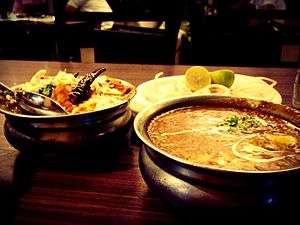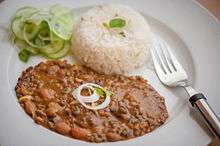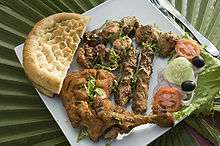Dal makhani
 Dal makhni and shahi paneer | |
| Alternative names | Maa di daal |
|---|---|
| Place of origin | India |
| Region or state | Punjab region, Indian subcontinent |
| Main ingredients | urad dal (black gram) |
| 350 kcal (1465 kJ) | |
Dal makhani or dal makhni (pronounced daal makh-nee, "buttery lentils") is a popular dish from the Punjab region of the Indian subcontinent. The primary ingredients are whole black lentil (urad), red kidney beans (rajma), butter and cream. The dish gets its richness from the use of cream, but it can also be prepared with yogurt, milk or no dairy.
History

Dal makhani is a staple in the Indian subcontinent. It was popularized in India following partition, when many people from the Punjab migrated to the northern regions of India.[1] As the Punjabi diaspora migrated across India and internationally, the dish was introduced to new locales by entrepreneurial Punjabi migrants Kundan Lal Jaggi, Kundan Lal Gujral and Thakur Dass,[2] [3] who opened the Moti Mahal restaurant in Daryaganj, Delhi, India.[4]
Dal makhani was first created by Punjabis and is now recognized as a quintessential Indian dish, and variations of the dish are served in many different restaurants internationally. Dal makhani’s popularity is due in part to its versatility in a meal: the rich vegetarian dish can be served as a main meal, included as part of a buffet (thali), or used as an accompaniment to a meal. In India, soups and curries with a red or yellow lentil base are an important staple, however, due to dal makhani's rich texture and lengthy preparation process, many Indians only consume the dish on days of significance, such as birthdays, national holidays, weddings and religious observances.
Preparation time
The traditional preparation of dal makhani involves a series of time-consuming procedures, which can take up to 24 hours to complete. With the availability of modern cooking equipment, namely electric pressure cookers, the preparation time of the dish has reduced significantly to 2–3 hours.
See also
Notes
References
- ↑ Prashant Bharadwat; Asim Khwaja; Atif Mian (30 August 2008). "The Big March: Migratory Flows After the Partition of India" (Article). Economic and Policy Weekly. pp. 39–49. Retrieved 29 April 2012.
- ↑ https://www.hindustantimes.com/brunch/punjab-on-a-platter/story-2e7rv1ngATLYLc2oEm4uBO.html
- ↑ http://www.sunday-guardian.com/investigation/partition-brought-moti-mahal-a-landmark-in-indias-culinary-history-to-central-delhi
- ↑ Sanghvi, Vir. "The modern dal makhani was invented by Moti Mahal".
| Wikibooks Cookbook has a recipe/module on |



